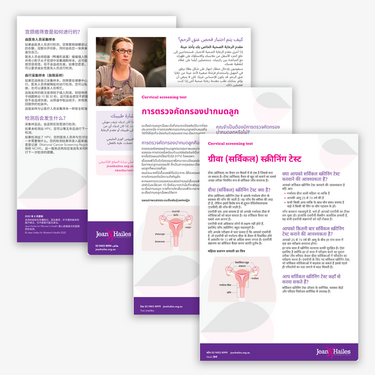
Need a refresher on the recent changes to cervical screening? Or is there something you’re not 100% clear on?
Here Professor Marion Saville AM, Executive Director of the Australian Centre for the Prevention of Cervical Cancer, provides her insight, answering top questions for health professionals.
All eligible women and people with a cervix are now able to collect their own sample for their cervical screening test. The aim is to reach those people who are uncomfortable with having a sample collected from their cervix by a health care practitioner. It is hoped that this new initiative will reduce the number of people dying of cervical cancer in Australia, currently around 200 per year.
We are well on the path to eliminating cervical cancer, but we have some serious inequity. Aboriginal and Torres Strait Islanders are more than twice as likely to develop this cancer, and nearly four times more likely to die from it than other Australians.
Others who may also be never- or under-screened include people in some culturally and linguistically diverse communities, some in the LGBTIQ+ community, people living with disability, people living in remote locations, people who have experienced sexual violence, and those with lower socio-economic status. For some of these people, the clinician-collected sample can be a barrier to screening.
The COVID-19 pandemic has impacted health seeking behaviours of many people, with more people delaying or deferring cancer screening and assessments. Overall fewer people than usually expected have had their cervical screening tests throughout the pandemic, and this leads to concerns that the opportunity to prevent cervical cancer may be lost for some women. And for others, later detection may mean that their cancer has progressed, leading to poorer cancer outcomes.
We know that the strongest determinant for following through with screening is the recommendation of a trusted health care provider. These providers have a critical role to play, and I would urge them to raise the issue of cervical screening during routine consultations.
Self-collection can also be offered during pregnancy and, for some people, might be one of the few opportunities to participate in screening. Asking about screening history should be part of routine ante-natal care. Those who are due or overdue for screening should be screened.

Ideally, the health professional will explain the difference between self-collection and a clinician-collected speculum examination. In situations where patients lack mobility, a clinician can assist with the vaginal sample and can use a swab. We have also found that people with large body size may find it difficult to take their own sample and may need assistance.
Flocked swabs (Copan FLOQ swab 552C or 553C.80) can be ordered from VCS Pathology here.
While we encourage health professionals to have their patients collect the samples in the practice – behind a curtain or in a bathroom – the setting can be flexible if the health professional is comfortable with it. This is because this results in the highest rate of sample collection.
VCS Pathology will, on request from a health professional, send out a kit with instructions to a patient and a reply-paid envelope. Results will be sent to the requesting health professional.
Yes, self-collected samples are as accurate as clinician-collected specimen for the detection of CIN2+.
If HPV Types 16 or 18 are detected – and they are responsible for 70-80% of cancers – then the patient needs to be referred to a specialist for a colposcopy, regardless of the collection method. We expect to detect Types 16/18 in around 2% of patients and other types of HPV will be detected in 6-8% of patients.
Detection of the other HPV types is highly age-dependent with detection more likely in younger patients. For those [who had] a clinician-collected cervical sample, the next step would be for the lab to do reflex Liquid based cytology (LBC) to determine whether immediate referral is required, or if a repeat test in a year is required.
Those who have collected their own sample will be advised to return to a health professional for a clinician-collected cervical test to LBC.
Self-collection should not be used in any setting where a co-test (both an HPV test and LBC, regardless of the result of the HPV test) is indicated. This includes anyone who has symptoms that might suggest the presence of cervical cancer, such as postcoital, intermenstrual or post-menopausal bleeding, or unexplained, persistent or unusual vaginal discharge, anyone currently undergoing test of cure following treatment for high-grade intraepithelial lesions or anyone who has ever been treated for adenocarcinoma in situ.
If there are no human cells on the swab, an invalid result is returned. The health professional should then have a sensitive conversation with the patient to ensure they were confident to collect the sample. Invalid tests run at about 2%, lower than for clinician-collected Pap smears.
HPV tests are far more sensitive for the detection of pre-cancer. Additionally, HPV infection is an earlier event in the development of cancer than the pre-cancerous changes detected by cytology. This means that if HPV is not present then the patient is very unlikely to develop cervical cancer for the next 5 to 10 years.
Many randomised control trials have now demonstrated that the rate of pre-cancer is lower five years after a negative HPV test than two years after a negative Pap test . Indeed, combined analyses of these trials confirms that women screened with HPV tests are much less likely to develop cervical cancer than those screened with cytology.
VCS Pathology has instructions on how to take a self-collection in 19 languages. Find them here.
Jean Hailes for Women's Health has also updated their cervical screening fact sheet for women with information on self-collection. The fact sheet is available in plain English and 13 other languages.

All reasonable steps have been taken to ensure the information created by Jean Hailes Foundation, and published on this website is accurate as at the time of its creation.
© 2024 Jean Hailes Foundation. All rights reserved. This publication may not be reproduced in whole or in part by any means without written permission of the copyright owner. Contact: licensing@jeanhailes.org.au